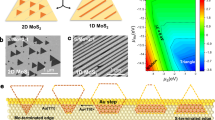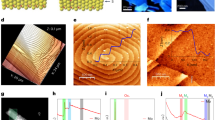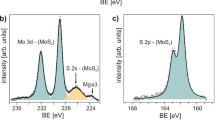Abstract
Two-dimensional transition-metal dichalcogenide (TMD) crystals are a versatile platform for optoelectronic, catalytic and quantum device studies. However, the ability to tailor their physical properties through explicit synthetic control of their morphology and dimensionality is a major challenge. Here we demonstrate a gas-phase synthesis method that substantially transforms the structure and dimensionality of TMD crystals without lithography. Synthesis of MoS2 on Si(001) surfaces pre-treated with phosphine yields high-aspect-ratio nanoribbons of uniform width. We systematically control the width of these nanoribbons between 50 and 430 nm by varying the total phosphine dosage during the surface treatment step. Aberration-corrected electron microscopy reveals that the nanoribbons are predominantly 2H phase with zig-zag edges and an edge quality that is comparable to, or better than, that of graphene and TMD nanoribbons prepared through conventional top-down processing. Owing to their restricted dimensionality, the nominally one-dimensional MoS2 nanocrystals exhibit photoluminescence 50 meV higher in energy than that from two-dimensional MoS2 crystals. Moreover, this emission is precisely tunable through synthetic control of crystal width. Directed crystal growth on designer substrates has the potential to enable the preparation of low-dimensional materials with prescribed morphologies and tunable or emergent optoelectronic properties.
This is a preview of subscription content, access via your institution
Access options
Access Nature and 54 other Nature Portfolio journals
Get Nature+, our best-value online-access subscription
$29.99 / 30 days
cancel any time
Subscribe to this journal
Receive 12 print issues and online access
$259.00 per year
only $21.58 per issue
Buy this article
- Purchase on Springer Link
- Instant access to full article PDF
Prices may be subject to local taxes which are calculated during checkout




Similar content being viewed by others
Data availability
The data that support the findings of this study are available from the corresponding author (T.J.K.) upon reasonable request.
Code availability
The cluster expansion code used in the current study is available from T.M. upon reasonable request.
References
Britnell, L. et al. Strong light-matter interactions in heterostructures of atomically thin films. Science 340, 1311–1314 (2013).
Voiry, D., Yang, J. & Chhowalla, M. Recent strategies for improving the catalytic activity of 2D TMD nanosheets toward the hydrogen evolution reaction. Adv. Mater. 28, 6197–6206 (2016).
Jaramillo, T. F. et al. Identification of active edge sites for electrochemical H2 evolution from MoS2 nanocatalysts. Science 317, 100–102 (2007).
Lee, C.-H. et al. Atomically thin p–n junctions with van der Waals heterointerfaces. Nat. Nanotechnol. 9, 676–681 (2014).
Najmei, S. et al. Vapour phase growth and grain boundary structure of molybdenum disulfide atomic layers. Nat. Mater. 12, 754–759 (2013).
Geim, A. K. & Grigorieva, I. V. Van der Waals heterostructures. Nature 499, 419–425 (2013).
Tielrooij, K.-J. et al. Nano-imaging of intersubband transitions in van der Waals quantum wells. Nat. Nanotechnol. 13, 1035–1041 (2018).
Zhou, Y. et al. Revealing the contribution of individual factors to hydrogen evolution reaction catalytic activity. Adv. Mater. 30, e1706076 (2018).
Li, S. et al. Edge-enriched 2D MoS2 thin films grown by chemical vapor deposition for enhanced catalytic performance. ACS Catal. 7, 877–886 (2017).
Blees, M. K. et al. Graphene kirigami. Nature 524, 204–207 (2015).
Wang, K. et al. Electrical control of charge carriers and excitons in atomically thin materials. Nat. Nanotechnol. 13, 128–132 (2018).
Unuchek, D. et al. Room-temperature electrical control of exciton flux in a van der Waals heterostructure. Nature 560, 340–344 (2018).
Shi, Y., Li, H. & Li, L. J. Recent advances in controlled synthesis of two-dimensional transition metal dichalcogenides via vapour deposition techniques. Chem. Soc. Rev. 44, 2744–2756 (2015).
Kang, K. et al. High-mobility three-atom-thick semiconducting films with wafer-scale homogeneity. Nature 520, 656–660 (2015).
Desai, S. B. et al. Gold-mediated exfoliation of ultralarge optoelectronically-perfect monolayers. Adv. Mat. 28, 4053–4058 (2016).
Zhang, X. et al. Diffusion-controlled epitaxy of large area coalesced WSe2 monolayers on sapphire. Nano Lett. 18, 1049–1056 (2018).
van der Zande, A. M. et al. Grains and grain boundaries in highly crystalline monolayer molybdenum disulphide. Nat. Mater. 12, 554–561 (2013).
Cho, B. et al. Phosphorus incorporation during Si(001):P gas-source molecular beam epitaxy: effects on growth kinetics and surface morphology. J. Appl. Phys. 103, 1–10 (2008).
Lee, C. et al. Anomalous lattice vibrations of single- and few-layer MoS2. ACS Nano 4, 2695–2700 (2010).
Gong, Y. et al. Tellurium-assisted low-temperature synthesis of MoS2 and WS2 monolayers. ACS Nano 9, 11658–11666 (2015).
Li, S. et al. Vapour-liquid-solid growth of monolayer MoS2 nanoribbons. Nat. Mater. 17, 535–542 (2018).
Yang, L. et al. Single-crystal atomic-layered molybdenum disulfide nanobelts with high surface activity. ACS Nano 9, 6478–6483 (2015).
Kong, D. et al. Synthesis of MoS2 and MoSe2 films with vertically aligned layers. Nano Lett. 13, 1341–1347 (2013).
Watts, M. C. et al. Production of phosphorene nanoribbons. Nature 568, 216–220 (2019).
Wu, R. J., Odlyzko, M. L. & Mkhoyan, K. A. Determining the thickness of atomically thin MoS2 and WS2 in the TEM. Ultramicroscopy 147, 8–20 (2014).
Wang, X. & Dai, H. Etching and narrowing of graphene from the edges. Nat. Chem. 2, 661–665 (2010).
Eda, G. et al. Coherent atomic and electronic heterostructures of single-layer MoS2. ACS Nano 6, 7311–7317 (2012).
Splendiani, A. et al. Emerging photoluminescence in monolayer MoS2. Nano Lett. 10, 1271–1275 (2010).
Mak, K. F., Lee, C., Hone, J., Shan, J. & Heinz, T. F. Atomically thin MoS2: a new direct-gap semiconductor. Phys. Rev. Lett. 105, 1–4 (2010).
Duan, X. et al. Lateral epitaxial growth of two-dimensional layered semiconductor heterojunctions. Nat. Nanotechnol. 9, 1024–1030 (2014).
Bao, W. et al. Visualizing nanoscale excitonic relaxation properties of disordered edges and grain boundaries in monolayer molybdenum disulfide. Nat. Commun. 6, 1–7 (2015).
Ataca, C., Sahin, H. & Ciraci, S. Stable, single-layer MX2 transition-metal oxides and dichalcogenides in a honeycomb-like structure. J. Phys. Chem. C 116, 8983–8999 (2012).
Scheuschner, N. et al. Photoluminescence of freestanding single- and few-layer MoS2. Phys. Rev. B 89, 1–6 (2014).
Mak, K. F. et al. Tightly bound trions in monolayer MoS2. Nat. Mater. 12, 207–211 (2013).
Dubey, S. et al. Weakly trapped, charged, and free excitons in single-layer MoS2 in the presence of defects, strain, and charged impurities. ACS Nano 11, 11206–11216 (2017).
Lin, Z. et al. Defect engineering of two-dimensional transition metal dichalcogenides. 2D Mater. 3, 1–22 (2016).
Wang, Y., Chen, X. & Hamers, R. J. Atomic-resolution study of overlayer formation and interfacial mixing in the interaction of phosphorus with Si(001). Phys. Rev. B 50, 4534–4547 (1994).
Sanchez, J. M., Ducastelle, F. & Gratias, D. Generalized cluster description of multicomponent systems. Phys. A 128, 334–350 (1984).
Metropolis, N., Rosenbluth, A. W., Rosenbluth, M. N., Teller, A. H. & Teller, E. Equation of state calculations by fast computing machines. J. Chem. Phys. 21, 1087–1092 (1953).
Mouri, S., Miyauchi, Y. & Matsuda, K. Tunable photoluminescence of monolayer MoS2 via chemical doping. Nano Lett. 13, 5944–5948 (2013).
Castellanos-Gomez, A. et al. Local strain engineering in atomically thin MoS2. Nano Lett. 13, 5361–5366 (2013).
Williams, K. R., Gupta, K. & Wasilik, M. Etch rates for micromachining processing – Part II. J. Microelectromech. Syst. 12, 761–778 (2003).
Ganta, D., Sinha, S. & Haasch, R. T. 2-D material molybdenum disulfide analyzed by XPS. Surf. Sci. Spectra 21, 19–27 (2014).
Kohn, W. & Sham, L. J. Self-consistent equations including exchange and correlation effects. Phys. Rev. 140, A1133–A1138 (1965).
Mueller, T. & Ceder, G. Bayesian approach to cluster expansions. Phys. Rev. B 80, 1–13 (2009).
Kresse, G. & Hafner, J. Ab initio molecular dynamics for liquid metals. Phys. Rev. B 47, 558–561 (1993).
Hammer, B., Hansen, L. B. & Nørskov, J. K. Improved adsorption energetics within density-functional theory using revised Perdew–Burke–Ernzerhof functionals. Phys. Rev. B 59, 7413–7421 (1999).
Perdew, J. P., Burke, K. & Ernzerhof, M. Generalized gradient approximation made simple. Phys. Rev. Lett. 77, 3865–3868 (1996).
Grimme, S., Antony, J., Ehrlich, S. & Krieg, H. A consistent and accurate ab initio parametrisation of density functional dispersion correction (DFT-D) for the 94 elements H-Pu. J. Chem. Phys. 132, 1–19 (2010).
Reckien, W., Janetzko, F., Peintinger, M. F. & Bredow, T. Implementation of empirical dispersion corrections to density functional theory for periodic systems. J. Comput. Chem. 33, 2023–2031 (2012).
Blöchl, P. E. Projector augmented-wave method. Phys. Rev. B 50, 17953–17979 (1994).
Wisesa, P., McGill, K. A. & Mueller, T. Efficient generation of generalized Monkhorst–Pack grids through the use of informatics. Phys. Rev. B 93, 1–10 (2016).
Acknowledgements
We thank B. Frank and H. Fairbrother at Johns Hopkins University (JHU) for assistance with XPS, and also thank the JHU Raman Scattering user centre. T.J.K. acknowledges start-up funding from JHU. J.K. acknowledges postdoctoral funding from the National Research Foundation of Korea (grant no. 2018R1A6A3A03010591). H.-G.P. acknowledges support from the National Research Foundation of Korea (grant no. 2018R1A3A3000666). T.M. acknowledges funding from the National Science Foundation (grant no. DMR-1352373). W.X. and D.H.G. acknowledge funding from the Air Force Office of Scientific Research MURI programme (no. FA9550-16-1-0031). T.H.B. acknowledges funding from the Office of Naval Research through the Naval Research Laboratory Base Program. D.J. and K.J. acknowledge support for this work by the US Army Research Office (contract no. W911NF1910109). T.J.K. and T.M. acknowledge supercomputer resources from the Maryland Advanced Research Computing Center. The near-field microscopy work was carried out at the Singh Center for Nanotechnology at University of Pennsylvania, which is supported by the NSF National Nanotechnology Coordinated Infrastructure Program under grant NNCI-1542153.
Author information
Authors and Affiliations
Contributions
T.J.K. and T.C. conceived the idea of using designer substrates to direct crystal growth, and designed experiments. All synthetic efforts were conducted by T.C., J.K. and E.C.S. with input and supervision from T.J.K. Sample preparations for STEM, Raman and PL studies were conducted by T.C., W.X. and S.W.L with input and supervision from H.-G.P., D.H.G., and T.J.K. Simulations were performed by C.L. with supervision and other mechanistic insights from T.M. and T.J.K. Raman and PL experiments were conducted by T.C., J.K. and S.W.L. with input and supervision from N.V.D., H.-G.P. and T.J.K. Near-field PL studies were conducted by K.J., T.C. and J.K. with input and supervision from D.J. and T.J.K. STEM experiments were conducted by T.H.B. with subsequent analyses by T.H.B. and T.J.K. The manuscript was written by T.J.K and T.C. with input from co-authors. All authors reviewed the manuscript before its submission.
Corresponding author
Ethics declarations
Competing interests
The authors declare no competing interests.
Additional information
Peer review information Nature Nanotechnology thanks Xidong Duan and the other anonymous reviewer(s) for their contribution to the peer review of this work.
Publisher’s note Springer Nature remains neutral with regard to jurisdictional claims in published maps and institutional affiliations.
Supplementary information
Supplementary Information
Supplementary Figs. 1–19.
Rights and permissions
About this article
Cite this article
Chowdhury, T., Kim, J., Sadler, E.C. et al. Substrate-directed synthesis of MoS2 nanocrystals with tunable dimensionality and optical properties. Nat. Nanotechnol. 15, 29–34 (2020). https://doi.org/10.1038/s41565-019-0571-2
Received:
Accepted:
Published:
Issue Date:
DOI: https://doi.org/10.1038/s41565-019-0571-2
This article is cited by
-
Scalable Generation of Hybrid Graphene Nanoscrolls for High-Performance Solid Lubricants
Tribology Letters (2024)
-
Synthetic two-dimensional electronics for transistor scaling
Frontiers of Physics (2023)
-
Tunable diodes made by atomically thin lateral heterojunction
Science China Materials (2023)
-
Controllable synthesis of high-aspect-ratio monolayer MoS2 nano-microribbons for high-performance phototransistors
Science China Materials (2023)
-
Epitaxial growth of inch-scale single-crystal transition metal dichalcogenides through the patching of unidirectionally orientated ribbons
Nature Communications (2022)



